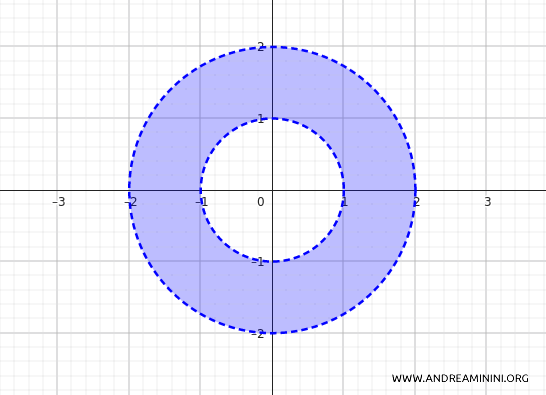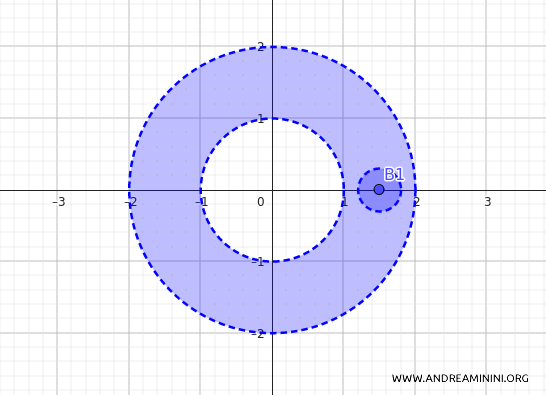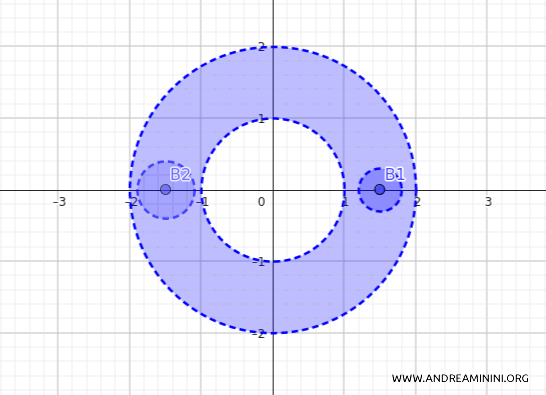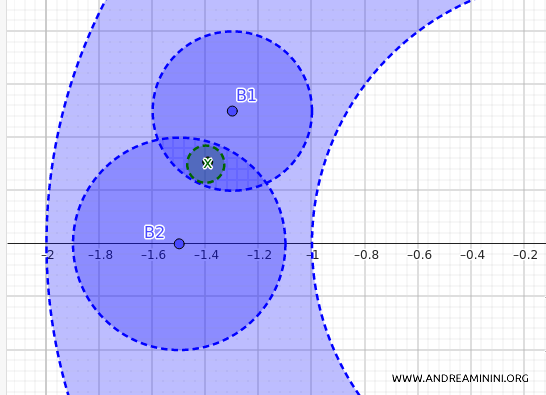Basis Theorem in the Topology Induced by a Metric
In a metric space \((X, d)\), the collection of open balls $$ \mathcal{B} = \{B_d(x, \varepsilon) \mid x \in X, \varepsilon > 0\} $$ forms a basis for a topology on \(X\).
A collection of open sets \(\mathcal{B}\) is a basis for a topology if every open set in the topology can be expressed as a union of sets from the basis.
Moreover, a collection \(\mathcal{B}\) is considered a basis if it satisfies the following two conditions:
- For every point \(x \in X\), there is at least one set \(B \in \mathcal{B}\) such that \(x \in B\). (Covering)
- If \(x \in B_1 \cap B_2\) for two sets \(B_1, B_2 \in \mathcal{B}\), then there exists a set \(B_3 \in \mathcal{B}\) such that \(x \in B_3 \subseteq B_1 \cap B_2\). (Intersection compatibility)
The theorem states that the collection of all open balls \(B_d(x, \varepsilon)\) satisfies these two conditions, and as such, can be used to define a topology on \(X\).
An open ball is the set of all points \(y \in X\) such that the distance between \(x\) and \(y\) is less than \(\varepsilon\) for any positive number \(\varepsilon\): $$ B_d(x, \varepsilon) = \{y \in X \mid d(x, y) < \varepsilon\}. $$
In simpler terms, this theorem shows that the topological structure of a metric space can be fully described using open balls.
An Example
Let’s look at an open set \(A\) in the plane \(\mathbb{R}^2\), defined as follows:
$$ A = \{(x_1, x_2) \in \mathbb{R}^2 \mid 1 < x_1^2 + x_2^2 < 4 \} $$
Geometrically, this set represents a ring in the plane, with an inner radius of 1 and an outer radius of 2.
It’s an open set because it excludes the boundaries of the circles with radii 1 and 2.

How can \(A\) be written as a union of open balls?
According to the basis theorem, \(A\) can be expressed as a union of open balls.
For example, we can take several open balls centered at points within the ring, each with a radius small enough to fit entirely inside the ring.
Consider the open ball centered at the point \(p_1 = (1.5, 0)\) with radius \(\varepsilon_1 = 0.3\), that is:
$$ B1_d((1.5, 0), 0.3) = \{(x_1, x_2) \in \mathbb{R}^2 \mid d((1.5, 0), (x_1, x_2)) < 0.3\} $$
This ball is entirely contained within the ring \(A\).

Next, consider the open ball centered at the point \(p_2 = (-1.5, 0)\) with radius \(\varepsilon_2 = 0.4\):
$$ B2_d((-1.5, 0), 0.4) = \{(x_1, x_2) \in \mathbb{R}^2 \mid d((-1.5, 0), (x_1, x_2)) < 0.4\} $$
This ball is also completely within the ring \(A\).

Continuing this process, we can construct many more open balls, centered at different points inside the ring, all with small enough radii to remain entirely within \(A\).
The key point is that we can cover the entire set \(A\) with a union of these open balls, leaving no "gaps" or empty spaces.
Formally, we can write:
$$ A = \bigcup_{i} B_d(x_i, \varepsilon_i) $$
Where \(x_i\) are the centers of various open balls and \(\varepsilon_i\) are their radii.
Each \(B_d(x_i, \varepsilon_i)\) is an open ball centered at \(x_i\) with radius \(\varepsilon_i\) such that the ball is contained in \(A\).
This example demonstrates how any open set (such as the ring \(A\)) in \(\mathbb{R}^2\) can be written as a union of open balls.
In other words, open balls are the "building blocks" that, when combined, describe the structure of open sets in a metric-induced topology.
Proof
The aim of the proof is to show that the collection of open balls in a metric space \((X, d)\) forms a basis for a topology on \(X\).
We do this by checking whether the conditions for being a basis are fulfilled:
1] The first condition states that every point in the space must belong to an open ball
This is easy to verify: for any point \(x \in X\), we can take the open ball \(B_d(x, \varepsilon)\) centered at \(x\) with radius \(\varepsilon > 0\).
Clearly, the point \(x\) belongs to \(B_d(x, \varepsilon)\) for any \(\varepsilon > 0\).
Therefore, the collection of open balls satisfies the first condition for being a basis, as every point in \(X\) is contained in at least one open ball.
2] The second condition requires that if a point \(x\) belongs to the intersection of two open balls \(x \in B_1 \cap B_2\), then there must be a smaller open ball \(B_3\) centered at \(x\) that is entirely contained within the intersection \(B_1 \cap B_2\).
This is crucial because it ensures we can "refine" the open balls around \(x\) and always find a smaller covering that respects the topology.
Let \(B_1\) and \(B_2\) be two open balls in \(\mathcal{B}\) (the collection of all open balls).
Assume \(x \in B_1 \cap B_2\). Therefore, \(x\) belongs to both \(B_1\) and \(B_2\).
We need to find an open ball \(B_3\) centered at \(x\) such that \(B_3\) is entirely contained within \(B_1 \cap B_2\).
If the point \(x\) is in the open ball \(B_1\), we can always find a smaller open ball centered at \(x\) that is entirely within \(B_1\), and the same applies for \(B_2\).
- For \(B_1\), there exists an open ball centered at \(x\) with a certain radius \(\delta_1\) such that \(B_d(x, \delta_1) \subseteq B_1\).
- For \(B_2\), there exists an open ball centered at \(x\) with a certain radius \(\delta_2\) such that \(B_d(x, \delta_2) \subseteq B_2\).
To obtain an open ball contained in both \(B_1\) and \(B_2\), we take the open ball centered at \(x\) with radius \(\delta = \min\{\delta_1, \delta_2\}\), which is the smaller of the two radii.
This ball \(B_d(x, \delta)\) will be contained in both \(B_1\) and \(B_2\), and therefore, it will be contained in \(B_1 \cap B_2\).

The second condition for being a basis is also satisfied.
In conclusion, I have demonstrated that the collection of open balls meets both conditions required to be a basis.
As a result, the collection of open balls forms a basis for a topology on \(X\), known as the topology induced by the metric.
And so forth.
